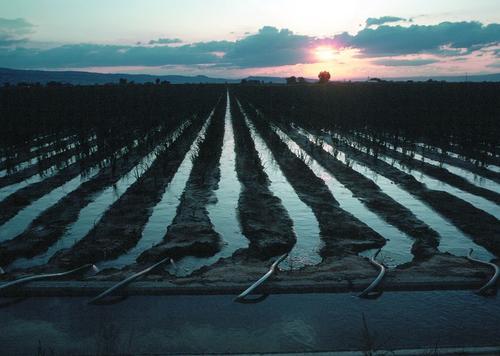Surface irrigation
Surface irrigation is mainly divided in basin, border, and furrow systems. It is widely utilized and therefore a well-known system, which can be operated without any high-tech applications. In general, it is more labour intensive than other irrigation methods. Proper design of surface irrigation systems takes into account the soil type (texture and intake rate), slope, levelness of the field, stream size and length of run. It is generally more difficult to obtain high uniformity of water distribution in long fields on coarse textured soils (gravel and sands) than on fine textured soils (loams to clay). (Hill et al. 2008)
Surface irrigation stands for a large group of irrigation methods in which water is distributed by gravity over the surface of the field (note: surface irrigation does not include spate irrigation). The three most common methods are basin irrigation, border irrigation and furrow irrigation. Water is typically introduced at the highest point or along the edge of a field, which allows covering the field by overland flow. Historically, surface irrigation has been the most common method of irrigating agricultural land. The defining feature of surface irrigation methods is that the soil is used as the transport medium. (Burt et al. 2000, Stauffer & Spuhler 2012b)
Surface irrigation methods contain two basic categories: ponding (surface water pooled in a puddle) and moving water. The moving water methods require some runoff or ponding to guarantee adequate infiltration at the lower end of the field. The soil type controls the length of the run and the depth of infiltrated over time. The better the quality of the soil is the lower is the unnecessary runoff and the better the infiltration into the soil and therefore the use for the crops. However, due to ponding it is important not to irrigate the crops during the day. In order to avoid evaporation-induced water loss, irrigation should be conducted in the early morning or at night. (Burt et al. 2000, Stauffer & Spuhler 2012b)
Each surface system has its own unique advantages and disadvantages depending on factors like initial development costs, size and shape of individual fields, soil characteristics, nature and availability of the water supply, climate, cropping pattern, social preferences and structures, and historical experience. (Walker 2003)
For further information regarding to the applicability, advantages and disadvantages of surface irrigation click here .
